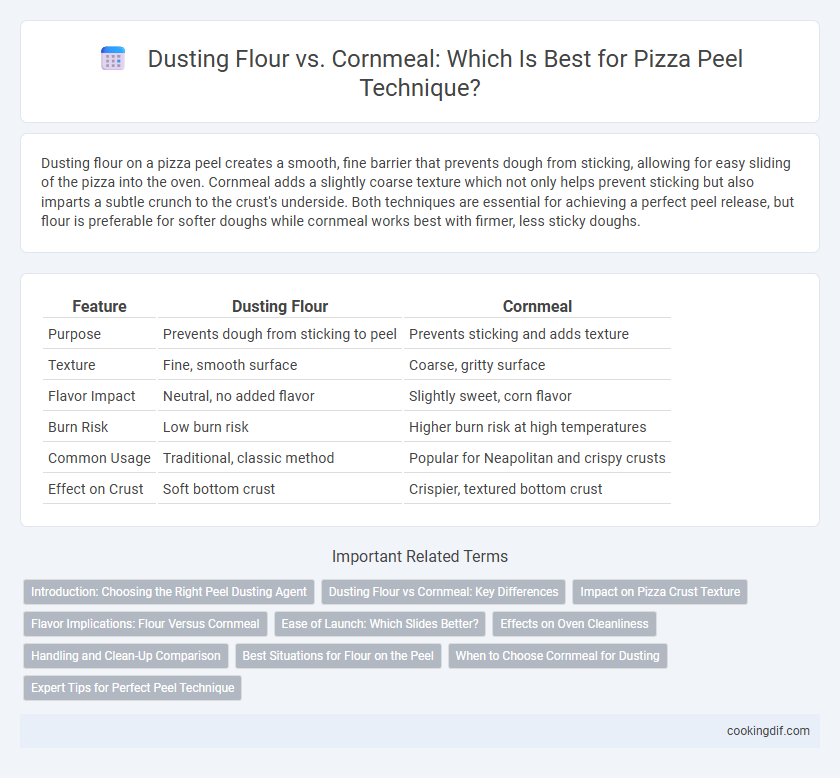Dusting flour on a pizza peel creates a smooth, fine barrier that prevents dough from sticking, allowing for easy sliding of the pizza into the oven. Cornmeal adds a slightly coarse texture which not only helps prevent sticking but also imparts a subtle crunch to the crust's underside. Both techniques are essential for achieving a perfect peel release, but flour is preferable for softer doughs while cornmeal works best with firmer, less sticky doughs.
Table of Comparison
| Feature | Dusting Flour | Cornmeal |
|---|---|---|
| Purpose | Prevents dough from sticking to peel | Prevents sticking and adds texture |
| Texture | Fine, smooth surface | Coarse, gritty surface |
| Flavor Impact | Neutral, no added flavor | Slightly sweet, corn flavor |
| Burn Risk | Low burn risk | Higher burn risk at high temperatures |
| Common Usage | Traditional, classic method | Popular for Neapolitan and crispy crusts |
| Effect on Crust | Soft bottom crust | Crispier, textured bottom crust |
Introduction: Choosing the Right Peel Dusting Agent
Choosing the right peel dusting agent is crucial to achieving a perfect pizza crust that slides effortlessly from peel to oven. Dusting flour creates a smooth, fine barrier that prevents sticking but can bake into the dough, sometimes altering texture or taste. Cornmeal offers a coarser, crunchier base that not only prevents sticking effectively but also adds a subtle, toasted flavor and crispness to the pizza bottom.
Dusting Flour vs Cornmeal: Key Differences
Dusting flour creates a smooth, fine barrier preventing the dough from sticking to the peel, enhancing easy transfer without affecting the crust texture. Cornmeal provides a coarser, grainy layer that adds a slight crunch to the pizza base while also facilitating a non-stick surface. Choosing between dusting flour and cornmeal depends on desired crust texture and ease of sliding the pizza onto the oven stone.
Impact on Pizza Crust Texture
Dusting flour on a pizza peel creates a smooth surface that allows the dough to slide easily into the oven, resulting in a softer, slightly chewier crust due to minimal interference during baking. Cornmeal acts as tiny ball bearings, preventing sticking while adding a subtle crunch and a slight grainy texture to the pizza crust's bottom. Choosing between flour and cornmeal significantly influences the crust's texture, with flour favoring tenderness and cornmeal enhancing crispness and structural integrity.
Flavor Implications: Flour Versus Cornmeal
Dusting a pizza peel with flour creates a subtle, neutral base that minimally alters the flavor of the dough, allowing the natural taste of the crust to shine through. Cornmeal, on the other hand, adds a crunchy texture and a slightly nutty, toasted flavor to the crust edges, enhancing the overall taste experience. Choosing between flour and cornmeal impacts not only the texture but also the aromatic profile of the baked pizza, influencing the final flavor complexity.
Ease of Launch: Which Slides Better?
Dusting flour on a pizza peel creates a smooth surface that allows dough to slide off quickly but can sometimes cause sticking if too much flour absorbs moisture. Cornmeal provides a coarse, grainy barrier that prevents sticking by creating tiny ball bearings, making the pizza easier to launch without tearing. For ease of launch, cornmeal typically offers better slide performance due to its natural non-stick texture and enhanced dough separation.
Effects on Oven Cleanliness
Dusting flour on a pizza peel tends to burn more quickly in the oven, creating sticky, charred residues that can be difficult to clean and may cause unpleasant smoke. Cornmeal acts as tiny ball bearings beneath the dough, reducing sticking without burning as rapidly, leading to a cleaner oven surface and easier peel release. Choosing cornmeal over flour helps maintain oven cleanliness by minimizing burnt residue buildup and smoking during baking.
Handling and Clean-Up Comparison
Dusting flour on a pizza peel offers a smoother release but tends to clump and stick more during handling, making clean-up slightly more labor-intensive due to residue buildup. Cornmeal provides a coarser, grittier surface that prevents dough from sticking effectively and usually falls off easily after transfer, simplifying peel maintenance. The choice between flour and cornmeal impacts both the ease of sliding the pizza off the peel and the efficiency of post-baking clean-up.
Best Situations for Flour on the Peel
Flour is best suited for doughs that are softer or higher in hydration, as it creates a thin, non-stick barrier without adding texture or grit to the pizza crust. It prevents the dough from sticking to the peel during shaping and transferring, especially when working with wet or sticky dough formulations. Using flour on the peel is ideal for achieving a smooth transfer in wood-fired ovens where a clean, lightly dusted surface ensures the pizza slides off easily.
When to Choose Cornmeal for Dusting
Cornmeal is ideal for dusting pizza peels when you want a gritty texture that prevents dough from sticking while adding a subtle crunch to the crust's edge. Unlike fine dusting flour, cornmeal's coarse grains create micro-barriers, allowing the pizza to slide effortlessly into the oven without absorbing moisture. Choose cornmeal for high-hydration doughs or thicker crusts where extra traction guarantees a smooth launch and a distinctive, toasted mouthfeel.
Expert Tips for Perfect Peel Technique
Using dusting flour on a pizza peel creates a fine, powdery layer that allows dough to slide smoothly while minimizing burning risks due to flour's low heat tolerance. Cornmeal provides a coarse, grainy base that prevents sticking effectively and adds a subtle texture to the crust's bottom but can brown or char faster in high heat. Experts recommend choosing dusting flour for thin, delicate doughs requiring gentle release and cornmeal for thicker, rustic crusts that benefit from added crunch and heat resistance.
Dusting flour vs Cornmeal for peel technique Infographic

 cookingdif.com
cookingdif.com